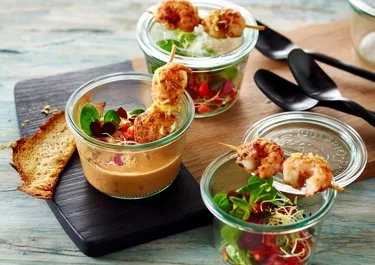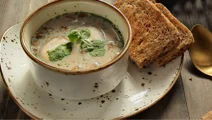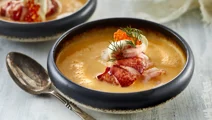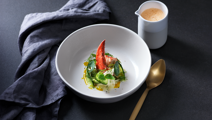Seafood soup with scampi skewers

A hearty seafood soup that is packed with taste, made with homemade seafood broth and served with delicious scampi skewers....it doesn’t get much better. Light, fresh and beautifully presented to bring colour to your dinner table. Prepare your seafood soup the day before and reheat when it’s time to serve, giving you more time for your guests. Seafood soup with scampi skewers is a perfect choice for your starter, main course or part of a larger menu.
Ingredients
Seafood broth
|
Rapeseed oil
|
2 tbsp |
|---|---|
|
Concentrated tomato purée
|
1 tbsp |
|
Shellfish shells, e.g. prawns, scampi or tiger prawns
|
100 g |
|
Chives, chopped (approximately 150 g)
|
2 |
|
Carrot, chopped (approximately 75 g)
|
1 |
|
Celery, chopped (approximately 100 g)
|
2 stalks |
|
Fresh parsley
|
5 stalks |
|
Small garlic clove, peeled
|
1 |
|
Lemon zest (unwaxed)
|
1 tsp |
|
Bay leaf
|
1 |
|
Black peppercorns
|
10 |
|
Coriander seeds
|
10 |
|
Water
|
1½ l |
Soup filling
|
Cocktail tomatoes
|
200 g |
|---|---|
|
Lamb's lettuce leaves
|
400 g |
|
Onions microgreen
|
100 g |
|
Red ribbon sorrel
|
30 g |
Scampi skewers
|
Bamboo skewers, medium – about 10 cm long
|
6 |
|---|---|
|
Norway lobster tails, peeled and raw
|
12 |
|
Butter
|
25 g |
|
Lemon zest (unwaxed)
|
1 tsp |
|
Coarse salt
|
½ tsp |
|
Freshly ground pepper
|
Seafood soup
|
Double cream
|
250 ml |
|---|---|
|
Coarse salt
|
1½ tsp |
For serving
|
French baguettes, toasted
|
6 slices |
|---|
Instructions
Seafood broth
Soup filling
Scampi skewers
Seafood soup with scampi skewers
How long is seafood soup good for?
When refrigerated, seafood can generally be reheated and consumed no more than 4-5 days after it was first prepared, and seafood soup is no different. As always, trust your sense of smell before deciding whether to reheat and consume. The usual risks when reheating seafood should be considered and it’s important to check for any signs of expiry, such as a change in smell. Store your seafood soup in a sealable container to avoid spoiling its rich flavour and taste. Reheat it slowly and over a low heat, without boiling, until it becomes piping hot and ready to serve.
Can you overcook prawns in soup?
Overcooked prawns can easily undo hours of hard work in the kitchen preparing and making your seafood soup. Overcooked prawns are both tough to chew and flavourless, so it’s important to pay close attention to timing when following your recipe – making sure your prawns are well cooked but not overcooked. Typically, you should cook your prawns on a low heat for around 2-3 minutes until they turn into their usual pink and white colour. You should also make sure to add your prawns at the very last step, making sure your prawns pack the most taste possible.
Do you wash scampi before cooking?
As with all seafood and meats, it’s important that you rinse prawns and scampi thoroughly under cold water before handling, cooking or eating. This will help you not only to remove any residue sand or dirt from the prawns or scampi, but more importantly most bacteria present on the seafood. However, keep in mind that this will not remove all bacteria and it’s still vital that you follow food safety guidelines when it comes to both personal hygiene, as well as cooking, storing and reheating seafood.
How do you know when scampi is cooked enough?
The best way to know when scampi, prawns and tiger prawns are considered cooked is to pay close attention to their colour, touch and smell. When cooked, scampi, prawns and tiger prawns will turn into their typical pink and white colours, as well as becoming firm to the touch and emitting a sweet-smelling aroma. If you’re still not sure and want to be on the safe side, use a thermometer to check the temperature. The temperature at the thickest part of the scampi or prawn should be at least 63 °C.
First things first
Seafood soup can come in many different variants, with many different ingredients and seafood choices. The first thing you need to decide is which seafood soup is the right one for you.
When it comes to seafood combinations, the list is almost endless. Whether you choose to use shellfish such as crab, lobster, prawns, scampi, or mussels; or fish such as cod, haddock or salmon. At the end of the day, it all depends on your personal taste and which ingredients are available, in season or the most affordable for your budget.
Skew it
For adults and children alike, skewers are the perfect way to add an extra touch of fun and taste to your dinner table.
Not only are they quick, convenient and social, but they also offer a culinary world of different taste combinations – whether you’re mixing different vegetables, fruits, meats or, as in this case, seafood. Each skewer is unique and can make your mealtimes anything but boring!








